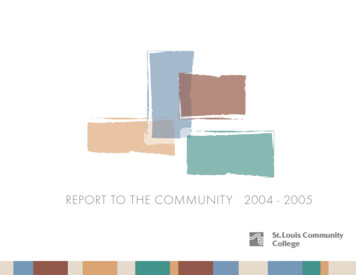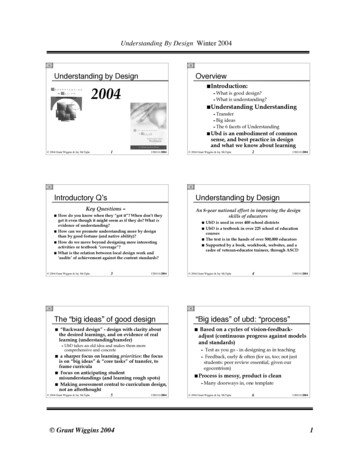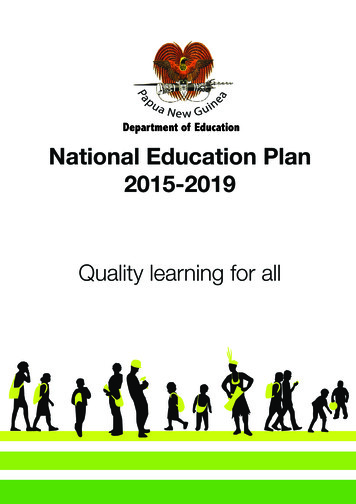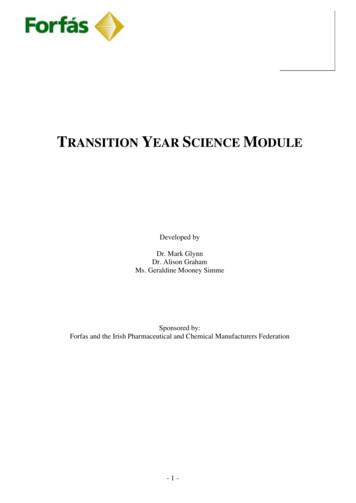
Transcription
REPORT TO THE COMMUNITY 2004 - 2005
MISSIONSt. Louis Community College expandsminds and changes lives every day.We create accessible, dynamiclearning environments focused on theneeds of our diverse communities.VISIONAL DIRECTIONS PREAMBLESt. Louis Community College is known for its qualityeducational programs and high standards andwill continue to ensure that our students learnand succeed in a safe, accessible, andprofessional environment. This vision anddirection are unwavering.
A MESSAGEThere’s an old saying–those whofail to plan, plan to fail. With themajor responsibility of providingeducation and training to thousands ofstudents who walk through our doorseach year, the College’s failure to planis not an option. Our future is full ofachievements and challenges, and wewill be successful because of our plan,our visional directions.We arrived at our visional directionsthrough the work of a committeeof faculty and staff districtwide. Thevisional directions are Leading inLearning, Addressing Facility Needs,Serving the Community and Growingthe Life Sciences.Throughout this report, we willshow how we already have put thesedirections into action. In the future,BOARDOFFROMTHECHANCELLORthese directions will guide the nextphase of our growth. These guidesprovide our faculty and staff with aflexible and broad path to continueand improve upon the work we haveperformed in the community for morethan 43 years.In the fall we will break ground onour new West County campus. Likeour other four locations– CosandCenter, Florissant Valley, Forest Parkand Meramec–and the many otherlocations throughout the communitywhere we provide our services, thiscampus will provide needed educationaland training services to students andbusinesses in the West County area.Using the visional directions as aguide, the West County campus willbuild upon the strong tradition ofteaching that is central to the communitycollege mission, while embodying thepossibilities available today throughadvances in communications, computertechnology and science.We at St. Louis Community Collegeare extremely proud of our history herein the metropolitan area, and we areeager to make our mark in the future.As our mission states, St. LouisCommunity College expands mindsand changes lives. Our standards arehigh, and the community deservesnothing less.Thank you for your continued andfuture support.Henry D. Shannon, Ph.D.TRUSTEESMichael P. RohrbackerPRESIDENTDolores J. Gunn, M.D.VICE PRESIDENTDenise R. ChachereMEMBERRobert C. NelsonMEMBERJoann L. Ordinachev, Ph.D.MEMBERLisa L. TaylorMEMBERMembers of the St. Louis Community College Board of Trustees are elected for six-year terms in four subdistricts of St. Louis City and County and portions of Franklin and Jefferson counties.The board is responsible for determining the policies of the College within the legal framework established by statutes of the state of Missouri. Board members make all final decisionsconcerning employment, termination of services, expenditure of funds, contracts, establishment of new programs, student fees, tax levies and facilities construction.1
LEADINGINLEARNING“We take very seriously our“To make the most of the fundsserve on Association of Communityand thereby stem a shortage of deafcommunications professionals.The College willresponsibility as one of the top 10available to build state-of-the-artCollege Trustees committees. Severalassume a leadershipcommunity college systems in thelearning facilities, the Dallasfaculty members serve as evaluators“We also continue to assess ourrole in innovationsnation,” said John W. Ganio, Ph.D.,representatives looked all over theof accrediting agencies, including thevalue to the community and expandthat support theSt. Louis Community College’s vicenation for models to emulate,” GanioNorth Central Association of Collegesour collaborative relationships,”mission of communitychancellor for education. “As asaid. “Their team of people said ourand Schools. Internal leadershipGanio said. “These partnerships withcolleges by encouragingfounding member of the League forfacility is the best in the nation. Theytraining opportunities exist for facultycommunity organizations, companies,advancements inInnovation in the Community College,plan to build according to some of theand staff.government agencies and otherteaching and learningwe recognize our leadership place inideas and standards we have at SouthSLCC students also assume leader-and new uses ofnational organizations and work hardCounty. What we have here is attractingship roles. For example, students in thedevelop resources to augment andtechnology, and byto enhance our reputation as a providernationwide interest and regard.”deaf communication studies programexpand our educational offerings,creating organizationalof world-class learning opportunities.”at Florissant Valley joined staff toand thereby open more doors tothe responsibility of leadershipactively work for passage of a stateopportunities for students.”structures andGanio said representatives of theFaculty and staff also take seriouslyschools provide opportunities tooperations that fosterDallas Community College Systemnationally. Chancellor Henry Shannonlaw to allow colleges to acceptArticulation agreements withefficiency andtwice visited SLCC’s South Countyrecently completed a term as chair ofAmerican Sign Language courses asinstitutions such as Southeasteffectiveness.Education and University Center andthe American Association of Communityforeign language credit. The legislationMissouri State University, Lindenwoodplan to use the facility as a model forColleges’ Board of Directors. Trusteescould increase the number of signUniversity, and the University ofconstruction of five new extension sites.Dolores Gunn and Joann Ordinachevlanguage courses taught statewideMissouri system significantly helpMore than 1,100 students from the campuses participated in the commencement ceremoniesat the Savvis Center.“Access to higher education is critical to improving the standard of living for allof us, and Southeast is committed to working with our sister institutions and thecommunities in our region to make postsecondary education available to all. Thecooperative agreements we have in place with SLCC will go a long way towardopening the doors of higher education for many place-bound St. Louis students.We commend SLCC for joining forces with us in these worthwhile endeavors."Kenneth W. Dobbins, Ph.D.2PRESIDENT, SOUTHEAST MISSOURI STATE UNIVERSITY
LEADING IN LEARNING:NOTEWORTHY ACHIEVEMENTSstudents achieve bachelor’s degreestransition between secondaryand beyond, in some cases withoutand postsecondary levels as wellleaving the St. Louis area throughas transitions to employment.online offerings. Flexibility in“This is one of the collaborativescheduling, including more Internetprograms in place to help moreand distance-learning courses, allowshigh school students becomestudents to take courses any time,college ready,” Ganio said. “Weanywhere. In addition to dualare the entry point for most kidsenrollment and Tech Prep programs,who want to attend college butGanio said the College is seekingcan’t afford it or are academicallyways to open more doors for highunprepared. Early interventionschool students.and implementation of strategiesSLCC is one of 15 communityto improve academic and skillscolleges nationally involved with theachievement should ensureCollege and Career Transitionshigh school graduates are preparedInitiative. This League for Innovationfor college or the work force.”project is designed to improveacademic performance and ease the Twenty-five Forest Park students participated in Creative.comm,an innovative blend of mass communications courses andadvanced computer art that is set in an agency environmentand team-taught. Groups of students worked on real-lifeprojects ranging from a Web page for the Arts and EducationCouncil to a brochure for the Wings of Hope golf tournament. With the help of accounting faculty, 24 Meramec studentinterns participated in the Volunteer Income Tax Assistanceprogram. The student interns assisted in preparation of 325 taxreturns for members of the community. Through a partnership with Junior Achievement of MississippiValley, some 70 Florissant Valley students taught speciallydesigned mini-units on free enterprise to elementary schoolstudents in north St. Louis County. Nearly 1,200 Meramec students participated in servicelearning/civic engagement activities, providing approximately3,045 hours of service. This service equates to a value of 96,000 by the Points of Light Foundation and VolunteerCenter National Network.Forest Park instructor Grace Lin helps students at Central Catholic St. Nicholas School learn about Chinese art and cultureduring a special Artist in Residence program.“We value most highly our partnerships and articulation agreementswith St. Louis Community College. The seamless pathway to abaccalaureate degree at UMSL, where students begin at SLCC, isa model for the state of Missouri, and offers students access to thevery best higher educational experience at an affordable cost. SLCCand UMSL are partnering extremely well to serve students andpromote the work force, economy and culture of the region.”Thomas F. George, Ph.D.CHANCELLOR, UNIVERSITY OF MISSOURI-ST. LOUIS3
SLCC and Lindenwood University signed an articulationagreement that will allow students who earn an associate’sdegree to transfer into bachelor’s degree programs atLindenwood. The College also signed an articulationagreement with Southeast Missouri State Universityto offer an online bachelor of general studies degree. Morris F. Johnson III, vice president for studentdevelopment services at Phoenix College in theMaricopa Community College District, was appointed toserve as the seventh president of the Forest Park campus. More than 700 College staff and students traveled toJefferson City in March for the Missouri Community CollegeDay Rally for Education. The Searchpath Interactive Tutorial, developed by librarystaff at the campuses, was named the district Innovationof the Year. The self-instructional tutorial teaches basiccollege-level research skills to help students more efficientlyfind information in the library and on the Web. The College received a 50,000 grant from the NationalMass Fatalities Institute to develop mass fatalities planningand response education modules for two- and four-yearinstitutions nationally that offer funeral service programs.The College also received a 98,000 grant to help educatefuneral home owners about their roles in mass fatalitiessituations. Graduates of the Clyde C. Miller Career Academy’s culinaryarts program will be welcomed into the hospitality studiesprogram at Forest Park with seven college credits under theirbelts. Michael Downey, co-chair of Forest Park’s hospitalitystudies and tourism department, helped design the academy’scurriculum to facilitate the students’ transition from highschool to college. Forest Park students successfully launched their own recordlabel, FoPa Records, one of the few student-run record labelsin the nation. Proceeds from sales will go toward studentscholarships and equipment.Evelynn Johnson serves as the executive producer of FoPa Records, the new student record label at Forest Park.4Jim Greer displays the Kennedy Center GoldMedallion he received in recognition of hiscontributions to college theater.
Jim Greer, professor of communications and director of theMeramec theater department, received the Kennedy Center/American College Theater Festival Gold Medallion during theRegion V American College Theater Festival that was co-hostedby the College and the University of Missouri-St. Louis. Florissant Valley’s humanities division created a learningcommunity to engage in a two-semester study of Italianlanguage and culture, culminating in a trip to Italy and asymposium to highlight learning outcomes. Chancellor Henry Shannon received a FOCUS St. Louis awardfor Creating Quality Educational Opportunities and the 2005President of the Year Award from the American StudentAssociation of Community Colleges. Supported by a grant from the Missouri Arts Council’s Artistin Residence program, Forest Park art staff conducted aworkshop focusing on Chinese art, history and culture for 5th7th grade students at Central Catholic St. Nicholas School. Two Florissant Valley students earned awards in the annualLeague for Innovation National Student Literary Competition.Kara Moyer earned first place for her poem, “Grandma’sEyebrows and the Funeral,” and Karen Satke received athird-place award for her one-act play, “Alice and the Dragon:A Bitter Play in One Act.” The College received a two-year, 540,000 grant fromGeorgetown University to participate in the CooperativeAssociation of States for Scholarships (CASS) programthat provides 17 students from Central America and theCaribbean an opportunity to study quality control at theFlorissant Valley campus. More than 2,170 associate’s degrees and 465 certificateswere conferred upon St. Louis Community Collegegraduates at the 2005 commencement program at the SavvisCenter. The College ranks among the top 20 associatedegree-producing institutions in the country.More than 700 staff and students traveled to Jefferson City to participate in theMissouri Community College Day Rally for Education.5
ADDRESSING FACILITY NEEDSThe College willWhen walking into a public building,“These items have to be in place forthere are some things a person expects.the educational process to take place,”address its building,Painted walls, light fixtures that work,Chance said. “Taking care of what werenovation, and capitalplumbing that does not leak. However,have is the first priority. There is noneeds, including thethese things do not just happen.higher priority than maintaining theexecution of plansPeople, and planning, keep all thoseresources the taxpayers have providedfor a fourth campuslittle things we take for grantedfor you.”in West County, thehumming right along.exploration of aAt St. Louis Community College,training center as wellthe people with the plans are Viceas sites in the City ofChancellor Carla Chance and theSt. Louis and Northphysical facilities division in chargeCounty that serveof campus and facility maintenance.the needs of thoseHer staff has developed a six-yeargeographic areas, andrepair and maintenance action planidentifying other majorfor the College.capital requirements. Student Center renovations on allthree campusesAccording to a recent proposal, Jack E. Miller Hospitality StudiesCenter and parking garage atForest Parkfacility would house four general- The Training Center and EmersonCenter for Engineering andManufacturing at Florissant Valleycommon areas for students, staffBut sometimes maintenance isor build new structures for its students.Over the last five years, SLCC haspurpose classrooms, laboratoryspace, administrative offices andand community members. West County CampusMore construction is in the College’snot enough. As with any growingenterprise, the College has had to addthe 25,000- to 30,000-square-footimmediate future. Projects on thedrawing board include: New Harrison Educationeither added to or built additionalfacilities to accommodate its expanding mission and meet the needs of thecommunity. The projects include: The Humanities East expansionat Meramecand Technology CenterMaintaining its accessibilityto the city’s North St. Louisresidents, the College’s newcenter would replace the currentbuilding on Natural Bridge Road.Situated on 66 acres in Wildwood,the new West County campus willreplace the College’s current facilitylocated at the historic Barn atLucerne in Ballwin. The newcampus will feature state-of-the-arttechnology and comprehensivestudent support services. The firstbuilding will be a three-story, 72,000square-foot structure, constructedRenovations to the Student Center at the Florissant Valley campus were completed.“Emerson is proud to have played a role in helping St. Louis Community College establishthis engineering and manufacturing center at the Florissant Valley campus. The curricula andtraining being offered at this facility will help the St. Louis region meet the growing needfor a work force skilled in using the latest manufacturing technologies.”David N. FarrCHAIR AND CEO, EMERSON6
ADDRESSING FACILITY NEEDS:NOTEWORTHY ACHIEVEMENTSwith environmentally friendly The Emerson Center for Engineering and Manufacturing wasopened and dedicated in fall 2004. In addition to Emerson,major donors to the center included the Boeing-McDonnellFoundation, Myrtle and Earl Walker, SBC Missouri, UnigraphicsEDS, Patriot Machine Inc. and the state of Missouri.materials and design. The Collegewill break ground for constructionin fall 2005, with plans to offer thefirst classes in fall 2007. A model for the new West County campus was presented tothe Board of Trustees in spring 2005.With all these plans, however, thefoundation is what is best for thosethe College serves. To address the Forest Park art department’s service andexpansion needs, the College purchased a building onHighland Park Drive to serve as a studio for sculpture,printmaking, photography and ceramics classes.“We need to have an open mindand keep the needs of our studentsand community at the center ofwhatever we do,” said ChancellorHenry Shannon. “Our goal is to offerthe best learning environments forour students.”The Emerson Center for Engineering and Manufacturing was dedicated in fall 2004.This model shows the front entrance to the new West County facility slated to open in fall 2007.This model shows the front entrance to the new West County facility slated to open in fall 2007.7
SERVINGTHECOMMUNITYAnticipating and responding toways to ensure that St. Louis remainsU.S. Department of Education.SLCC’s Academy partners. They andSt. Louis Communitythe educational needs of the St. Louisa viable source for skilled workers forAccording to Steve Long, SLCC’sother companies have joined theCollege will enhancecommunity have been hallmarks oflocal businesses and industries, asdirector of Workforce and CommunityCollege, the St. Louis County Economicits visibility, presenceSt. Louis Community College for morewell as for out-of-state companiesDevelopment, the academy is preparingCouncil, and area high schools andin, and service tothan 40 years. SLCC has offeredseeking a substantial pool of qualifiedtoday’s high school students to filluniversities in the region to developthe community withcareer training to veterans returningworkers in a major city.important engineering roles inand promote a strong two- and four-a strengthened focusfrom Vietnam, programs to helpSt. Louis in the near future.year college preparatory program inon job training andwomen enter or re-enter the workRegional Academy of Engineering,economic development,force, occupational training for thosea virtual academy whose primary goalretiring very soon, which will createto introduce high school students toprograms that addressalready in the work force, and, ofis to grow the region’s engineeringa huge number of job openings,” Longthe scope, rigor and discipline of thesecommunity needs,course, general education programsand engineering technology work force.said. “We are trying to ensure thatfields prior to entering college. Nearlyand increasedfor students with plans to earnThe SLRAE is based on the ideals ofthere are qualified people to fill those600 students at more than a dozenpartnerships.advanced degrees.Project Lead the Way, a nationalpositions. That’s why we are sohigh schools currently are enrolled inSLCC also has embraced itsnon-profit organization dedicated toactively supported by local industry.”the program–a 300 percent increaseresponsibility to contribute to thethe same goals, and is funded by aAmeren Services, the Boeing Co.economic development of the St. Louisgrant the College received in 2003and Tyco/Mallinckrodt, all of whombelieves that number will more thanregion. The College extends its reachthrough the League for Innovationhave a vested interest in cultivatingdouble in 2006.beyond the classroom in a number ofin the Community College and theyoung engineering talent, are amongOne such initiative is the St. Louis“Many engineers in the area will beengineering and engineering technologyover last year–and Long said heAs SLCC paves the way for futureThe Construction Prep Center is an 8-week training program thatprepares participants for entry into carpentry and other skilled trades.“At SBC, we regard the expansion of technology education as an opportunityfor economic development because all of Missouri benefits by having a work forceeducated for high-tech jobs. Companies can’t locate where there is no one to dothe work. This is particularly true of employment in the high-tech sector.”Cynthia J. BrinkleyPRESIDENT, SBC MISSOURI8
SERVING THE COMMUNITY:NOTEWORTHY ACHIEVEMENTSemployees, it continues to support, educateand train the current St. Louis-area workforce. The College operates seven MissouriCareer Centers throughout the city and countythat offer training, counseling and job-seekingservices to the community, as well astransition assistance to displaced or laid-offworkers. The Construction Prep Center(CPC), as part of the Metropolitan Educationand Training (MET) Center, addresses issuesof diversity in the construction work forceand prepares individuals for placement inunion apprenticeship programs and foremployment in the construction trades.These and many other outreach programsthroughout St. Louis Community Collegeunderscore the College’s commitment tobuilding a stronger community.St. Louis Community College received a 149,885 grant from the U.S.Department of Health and Human Services to initiate the Head StartHispanic/Latino Service Partnership (HSHLSP), which will prepare HeadStart teachers to enter the College’s associate degree program in early careand education, and continue into a bachelor’s program in early childhoodeducation. The partnership is with the Grace Hill Settlement House. The College was awarded 112,685 from the MissouriDepartment of Elementary and Secondary Education forthe Meramec campus to continue its Adult Educationand Literacy program. The College received a 1.4 million grant from the St. LouisCounty Department of Human Services for Workforce andCommunity Development to provide employment andtraining services to adult and dislocated workers residingin St. Louis County. The College received a four-year grant of 880,000 from theU.S. Department of Education for the Florissant Valley campusto continue its implementation of a Student Support Servicesprogram for first-generation and low-income students. As part of the U.S. Centers for Disease Control (CDC) andthe Missouri Department of Health and Senior Services jointemergency response Strategic National Stockpile (SNS) exercisein June, the Meramec gymnasium was transformed into a clinicand served as a closed dispensing site for local healthcareagencies to test their plan for the mass distribution ofthe CDC 12-hour push package as well as other medicalproducts to be dispensed in the event of a large-scale healthemergency. Volunteers participated as role players andreceived mock medication. In a partnership with Walnut Grove Elementary School,Florissant Valley faculty and staff throughout the year sharedtheir talents with the children at Walnut Grove through theatreinterpretation, science/engineering demonstrations, career andcollege placement workshops and mentoring. The College initiated GROWTH (Greater Regional Opportunitiesfor Workforce Training and Higher Education), an eight-monthproject to solicit information and advice from the communityon workforce development issues. SLCC is the largest source forworkforce training in the region, and the project will enable theCollege to develop new programs and facilities to meet thearea’s future business, industrial and labor needs. Through its Good Neighbor Initiative, community-based researchand outcomes, Meramec students conducted a door-to-doorsurvey in Webster Groves to help city officials identify communityneeds, especially among older residents. The College’s Center for Business, Industry and Labor markedits 20th year of providing on-site customized training andconsulting services to large and small businesses throughoutthe St. Louis metropolitan area.The goal of the St. Louis Regional Academyof Engineering is to prepare students tofill important engineering roles in St. Louis.9
GROWINGTHELIFE SCIENCESMissouri is one of the hottestinitiative. “We provide pathways foruniversities. The College’s Tech Prepand change, Perkins said programmingThe College willstart-up markets for life sciencesstudents to get advanced degrees orprogram has articulation agreementsdoes the same. College officials areexpand its role tocompanies inventing and buildingto immediately enter the work force.”with more than 12 high schools.exploring options in plant science,take a major positionproducts for the future. Nearly 400Since St. Louis was branded as theArticulation agreements also existnanotechnology and allied health, within serving theplant and life sciences enterprisesBioBelt in 2000, the College has workedwith Southeast Missouri Statethe assistance of industry experts whoimportant andoperate in the St. Louis area alone,closely with the St. Louis RegionalUniversity, the University of Missouriserve on SLCC advisory committees.fast-growingaccounting for some 22,000 employees.Chamber and Growth Association andand St. Louis University in programsthe St. Louis Economic Council tosuch as horticulture, industrialsaid Karen Kiser, professor anddirector of the clinical laboratorydevelopment ofIndustry experts agree that onethe life scienceskey to ensuring long-term growth isexplore workforce development possi-technology and respiratory therapy.in the region.a well-trained work force.bilities. For the past five years, SLCC’sSLCC also has close connections“St. Louis Community College plays“New technologies are emerging,”technology/phlebotomy program at thebiotechnology program has filled anwith the life sciences industry. ACollege’s Forest Park campus. “Medicala key role in this growth because ourimmediate need for highly skilled labfounding member of the Missouriprofessionals of tomorrow may haveprograms provide lab technicians whotechnicians for companies such asBiotechnology Association, SLCCto be prepared to use 3-D computercan support research and development,Sigma-Aldrich, Monsanto and theis working with the St. Louis Economicimaging in radiology, nanotechnologyas well as step right into positionsDanforth Plant Science Center.Council to develop workforce trainingto provide early diagnosis of disease,programs for post-incubator companies,or personal monitoring networks forfrequent assessment of patients.”with existing companies,” said SarahThe College continues to developPerkins, Ph.D., executive dean atand expand educational opportunitiesand with the Danforth Plant ScienceSLCC-Florissant Valley, who alsoby partnering with local technical highCenter on other training initiatives.oversees the district’s life sciencesschools and other colleges andAs the industry continues to growSLCC also has been invited to bea regional Bio-Link Center, a projectThe biotechnology program at Florissant Valley has filled an immediate need for highly skilled labtechnicians for companies such as Sigma-Aldrich, Monsanto and the Danforth Plant Science Center.“Our state’s proactive program being aimed at the communitycollege shows that we are very forward thinking in building outthe infrastructure of talent that we need. The community collegesystem is the backbone of workforce development.”Travis BrownPARTNER, GAINES BROWN CONSULTING LLC10
GROWING THE LIFE SCIENCES:NOTEWORTHY ACHIEVEMENTSfunded by the National Science Foundationto improve and expand educational programsthat prepare skilled technicians for work The College’s Mobile Tech Center, which hosted morethan 800 visitors to its biotechnology presentation,received the Technology Innovation Award from theMissouri Community College Association for creative andeffective use of technology in community colleges.in the high-tech fields that drive the U.S.economy. College staff also are makingpresentations and attending conferencesacross the country to enhance course The Meramec horticulture department and GatewayGreening signed a memorandum of understanding todevelop joint horticulture programs.offerings. SLCC will be a presentingcommunity college at the InternationalBIO Conference later this year.“Life sciences are like morphing a St. Louis Community College was selected to be apresenting community college at the 2005 InternationalBIO Conference.butterfly,” Perkins said.“Missouri is inthe early stages of growth in some ways.We are in the cocoon stages with some ofour programs getting ready to take flight.The state needs the work force. It’s ourPharmacy technician training program is one of the newest programs offeredthrough the Allied Health division at Forest Park.role to continue to improve our programs For the third straight year, Florissant Valley’s nursingdepartment achieved a 100 percent pass rate on thenational test for graduating nurses. The national averageis 82.6 percent.to match actual practices and experiencesstudents will encounter on the job.”“The initial employees of start-ups are at the Ph.D. level. As thosecompanies mature, they will need many technicians to operateproduction. That is where St. Louis Community College will beneeded. We are working with Dr. Shannon on a new capability toput technician training centers closer to future employers.”Gateway Greening and the Meramechorticulture department signed amemorandum of understanding todevelop joint horticulture programs.Roger Beachy, Ph.D.PRESIDENT, DONALD DANFORTH PLANT
baccalaureate degree at UMSL, where students begin at SLCC, is a model for the state of Missouri, and offers students access to the very best higher educational experience at an affordable cost. SLCC and UMSL are partnering extremely well to serve students and promote the work force, economy and culture of the region." Thomas F. George, Ph.D.











